M
I
C
R
O
S
T
O
R
Y
O
F
A
R
T
........................................................

NOW COMPLETED:

........................................................
MICROSTORY OF ART
ONLINE JOURNAL FOR ART, CONNOISSEURSHIP
AND CULTURAL JOURNALISM
........................................................
INDEX | PINBOARD | MICROSTORIES |
FEATURES | SPECIAL EDITIONS |
HISTORY AND THEORY OF ATTRIBUTION |
ETHNOGRAPHY OF CONNOISSEURSHIP |
SEARCH

........................................................



 >MICROSTORIES
>MICROSTORIES
- Richard Serra
- Martin Scorsese
- Claude Simon
- Sunshine
- Werner Herzog
- The Creation
- Marcel Duchamp
- Nino Rota
- Wölfflin and Woolf
- Hansjörg Schneider
- Kraftort Arkadien
- Visual Biography
- Schlaraffenleben
- Die Geisteswissenschaften
- The Voyeur
- Buzzword Sustainability
- Paul Verlaine
- Tao Yuanming
- New Beginning
- Seneca
- Still Lifes
- Charles Baudelaire
- Frédéric Chopin
- The Art History of Sustainability
- Wang Wei
- Solarpunk
- Historians of Light
- Lepanto
- Renaturalization
- Plates
- Snow in Provence
- Learning to See
- Picasso Dictionaries
- Peach Blossom Spring
- Picasso Tourism
- Tipping Points
- Sviatoslav Richter
- Weather Reports
- Treasure Hunt
- Another Snowscape in Picasso
- Picasso in 2023
- Dragon Veins
- The Gloomy Day
- The Art of the Pentimento
- Reforestation
- The Status of Painting
- Emergency Supply
- Punctuality
- Watching Traffic
- Zhong Kui
- How Painting Survived the 1990s
- Confirmation Bias
- Sustainability and Luxury
- Garage Bands
- Picasso and Artificial Intelligence
- Eyes of Tomorrow
- Picasso in 2023 2
- Gluing Oneself to Something
- Suburbia
- Bamboo
- Sustainability and Carpe Diem 1
- Interviews with Bruegel
- Sustainability and Carpe Diem 2
- Coffee & Sugar
- Bamboo 2
- Picasso in 2023 3
- Sustainability and Carpe Diem 3
- Cherry Orchard
- Old Magazines
- Chance
- Nick Drake
- Harlequin
- The Smartphone & the Art Book
- Atlas Syndrome
- The Kitchen
- Atlas Syndrome 2
- Consideration
- Tori Amos
- School
- Orchard Auctioning Day
- The Hundred Years’ War
- Sócrates
- Chameleon
- Nefertiti Bust
- Picasso as a Computer
- Sunflowers
- Philemon & Baucis
- Ode to the Radio
- Childhood
- Wimmelbild
- Restitution
- Nick Drake 2
- Wishful Thinking
- Sundays
- The Independent Scholar
- September
- The Fisherman by Pirosmani
- Microadventure
- Sociology
- Salvator Mundi
- Chillon
- Appassionata
- Amber
- Homer
- Berlin
- Planet Walk
- Improvisation
- Seeing Picasso
- These Nice Kids
- Robber
- The One
- The Sea Turtle
- Zoo
- Through the Hush
- Wunderkammer
- I Do Not Seek, I Find
- Shopping Mall
- Food Hamper
- The Secretary
- This Gate
- Nor Rainy Day
- House on a Hill
- Beautiful Island
- Second-hand Bookstore
- Flat
- Slap in the Face
- Serra, Wenkenpark
- Apologies
- The Bells
- Nordmann Fir
- Picasso Wanting To Be Poor
- Picasso, Pirosmani
- A Brief History of Sculpture
- 24 Sunsets
- Rusty Phoenix
- Glove
- Wintry Stanza
- A Song
- Like A Beatle
- Catching An Orange
- Solar Bees
- Permaculture

 >FEATURES
>FEATURES
- Van Gogh On Connoisseurship
- Two Museum’s Men
- Ende Pintrix and the City in Flames
- Titian, Leonardo and the Blue Hour
- The Man with the Golden Helmet: a documentation
- Un Jury d’admission à l’expertise
- Learning to See in Hitler’s Munich
- Leonardo da Vinci and Switzerland
- The Blue Hour Continued
- The Blue Hour in Louis Malle
- Kafka in the Blue Hour
- Blue Matisse
- Blue Hours of Hamburg and LA
- A Brief History of the Cranberry
- The Other Liberale in the House
- The Blue Hour in Raphael
- Who Did Invent the Blue Hour?
- Monet on Sustainability
- Velázquez and Sustainability
- The Blue Hour in Guillaume Apollinaire
- Van Gogh on Sustainability
- The Blue Hour in Marcel Proust
- Picasso and Sustainability
- The Contemporary Blue Hour
- The Blue Hour in 1492
- The Blue Hour in Hopper and Rothko
- Hopper and Sustainability
- The Blue Hour in Ecotopia
- The Hour Blue in Joan Mitchell
- Explaining the Twilight
- The Twilight of Thaw
- The Blue Hour in Pierre Bonnard
- Explaining the Twilight 2
- Picasso on Stalin
- Rubens on Sustainability
- The Salvator Mundi in Bruegel and Rubens
- The Blue Hour in Leonardo da Vinci and Poussin
- The Blue Hour in Rimbaud
- Faking the Dawn
- Frost and Thaw in Ilya Ehrenburg
- Picasso, Stalin, Beria
- Picasso, Solzhenitsyn and the Gulag
- Shostakovich on Picasso
- Hélène Parmelin in 1956
- Historians of Picasso Blue
- Picasso Travelling to Moscow 1
- The Blue Hour in Caravaggio
- Picasso Travelling to Moscow 2
- Picasso, the Knife Game and the Unsettling in Art
- Some Notes on Leonardo da Vinci and Slavery
- Picasso Moving to the Swiss Goldcoast
- The Blue Hour in Camus
- The Blue Hour in Symbolism and Surrealism
- Caspar David Friedrich in His Element
- Exhibiting the Northern Light
- Caspar David Friedrich in His Element 2
- Robert Schumann and the History of the Nocturne
- The Blue Hour in Robert Schumann
- Caspar David Friedrich and Sustainability
- The Twilight of Thaw 2
- Multicultural Twilight
- The Blue Hour in Anton Chekhov
- The Blue Hour in Medieval Art
- Twilight Photography
- The Blue Hour in Bob Dylan
- Iconography of Optimism

 >SPECIAL EDITIONS
>SPECIAL EDITIONS
- Visions of Cosmopolis
- Mona Lisa Landscapes
- Turner and Ruskin at Rheinfelden
- Painters On TV & On TV
- Spazzacamini in Art
- A Last Glance at Le Jardin de Daubigny
- The Experimental Cicerone
- A Dictionary of Imaginary Art Historical Works
- Iconography of Blogging
- Begegnung auf dem Münsterplatz
- Cecom
- Das Projekt Visual Apprenticeship
- Those Who See More
- A Fox on Seeing with the Heart
- Sammlung Werner Weisbach
- Daubigny Revisited
- Some Salvator Mundi Microstories
- Some Salvator Mundi Afterthougths
- Some Salvator Mundi Variations
- Some Salvator Mundi Revisions
- A Salvator Mundi Questionnaire
- A Salvator Mundi Puzzle
- Unknown Melzi
- Francis I and the Crown of Charlemagne
- From Amboise to Fontainebleau
- Drones Above Chambord
- Looking Back At Conques
- Flaubert At Fontainebleau
- Images of Imperial Ideology
- The Chronicles of Santa Maria delle Grazie
- Seeing Right Through Someone
- Melzi the Secretary
- Eying Glass
- A Foil to the Mona Lisa
- A Renaissance of the Cartoon
- Sketching a Family Tree
- Venetian Variations
- A Brief History of Digital Restoring
- A Consortium of Painters
- Leonardeschi and Landscape
- A Christ in Profile
- Learning to See in Spanish Milan
- A History of Gestures
- Leonardo and Josquin
- A Renaissance of the Hybrid
- Suida and Heydenreich
- The Watershed
- Three Veils
- From Beginning to End
- Connoisseurship of AI
- Twilight and Enlightenment
- The Blue Hour in Chinese Painting
- Dusk and Dawn at La Californie
- Iconography of Sustainability
- The Blue Hour in Goethe and Stendhal
- The Sky in Verlaine
- The Blue Hour in Paul Klee
- Iconography of Sustainability 2
- The Blue Hour in Charles Baudelaire
- From Bruegel to Solarpunk
- Some Salvator Mundi Documentaries
- Some More Salvator Mundi Monkey Business
- The Windsor Sleeve
- Brigitte Bardot’s Encounter with Picasso
- Art Historians and Historians
- A Salvator Mundi Chronicle
- The Salvator Mundi and the French Revolution
- The Fontainebleau Group
- The Encounter of Harry Truman with Pablo Picasso
- The Fontainebleau Group Continued
- The Windsor Sleeve Continued
- The Salvator Mundi in Early Netherlandish Painting 1
- Some Salvator Mundi Resources
- A New Salvator Mundi Questionnaire
- The Woman in Picasso
- The Yarborough Group
- Melzi, Figino and the Mona Lisa
- The Yarborough Group Continued
- A Salvator Mundi Global History
- The Salvator Mundi in Medieval Art
- The Salvator Mundi in Medieval Art 2
- The Salvator Mundi in Early Netherlandish Painting 2


 >HISTORY AND THEORY OF ATTRIBUTION
>HISTORY AND THEORY OF ATTRIBUTION
- The Mysterious »Donna Laura Minghetti-Leonardo«
- Assorted Demons of Connoisseurship
- Panofsky Meets Morelli
- Discovering the Eye of Sherlock Holmes
- Handling the Left-handed Hatchings Argument
- Visual History of Connoisseurship
- Alexander Perrig
- Connoisseurship in 2666
- What Postmodernity Has Done to Connoisseurship
- Dividing Four Fab Hands
- A Leonardesque Ambassador
- Test Cases in Connoisseurship
- A Raphael Expertise
- How to Tell Titian from Giorgione
- Louise Richter
- The Unique Property in the History of Connoisseurship
- An Expertise by Berenson
- The Book of Expertises
- An Album of Expertises
- An Expertise by Friedländer
- A Salvator Mundi Provenance
- How to Tell Leonardo from Luini
- An Expertise by Crowe and Cavalcaselle
- An Expertise by Bayersdorfer
- An Expertise by Hermann Voss
- An Expertise by Hofstede de Groot
- Leonardeschi Gold Rush
- An Unknown »Vermeer«
- An Expertise by Roberto Longhi
- An Expertise by Federico Zeri
- A Salvator Mundi Geography
- A Salvator Mundi Atlas
- The Bias of Superficiality
- 32 Ways of Looking at a Puzzle
- James Cahill versus Zhang Daqian
- Five Fallacies in Attribution
- On Why Art History Cannot Be Outsourced to Art Dealers
- On Why Artificial Intelligence Has No Place in Connoisseurship
- Salvator Mundi Scholarship in 2016
- Leonardo da Vinci at the Courts
- The Story of the Lost Axe
- The Last Bruegel
- A Titian Questionnaire
- On Where and Why the Salvator Mundi Authentication Did Fail
- The Problem of Deattribution

 >ETHNOGRAPHY OF CONNOISSEURSHIP
>ETHNOGRAPHY OF CONNOISSEURSHIP
MICROSTORY OF ART
ONLINE JOURNAL FOR ART, CONNOISSEURSHIP
AND CULTURAL JOURNALISM
........................................................

***
ARCHIVE AND FURTHER PROJECTS

1) PRINT


***
2) E-PRODUCTIONS


........................................................

........................................................

........................................................
FORTHCOMING:


***
3) VARIA

........................................................

........................................................

........................................................

........................................................

........................................................
***
THE GIOVANNI MORELLI MONOGRAPH

- The Giovanni Morelli Monograph
........................................................
MICROSTORY OF ART
ONLINE JOURNAL FOR ART, CONNOISSEURSHIP AND CULTURAL JOURNALISM
HOME
| MICROSTORY OF ART ONLINE JOURNAL FOR ART, CONNOISSEURSHIP AND CULTURAL JOURNALISM A Salvator Mundi Geography |
See also:
Some Salvator Mundi Microstories
Some Salvator Mundi Afterthoughts
Some Salvator Mundi Variations
How To Tell Leonardo From Luini
A SALVATOR MUNDI GEOGRAPHY
This is meant to propose the new hypothesis that the Salvator Mundi version in possession of the Detroit
Institute of Arts (above) is an Antwerp copy after a lost painting of Italian character which, however, is not
the notoriously famous Abu Dhabi Salvator Mundi version and also was not necessarily by Leonardo.
This new hypothesis, nonetheless, has some implications affecting the notoriously famous Abu Dhabi painting
as well as the narrative that backs an attribution to Leonardo da Vinci, and we also shall unfold these implications here.
Below on the left, and against a red background, we give our reasons that make us propose the new hypothesis.
On the right, and against a golden background, we shall give some dates from Flemish and Netherlandish history,
as well as some dates from the history of Salvator Mundi paintings and Salvator Mundi studies.
(Begun: 4 January 2020; completed: 7 January 2020)
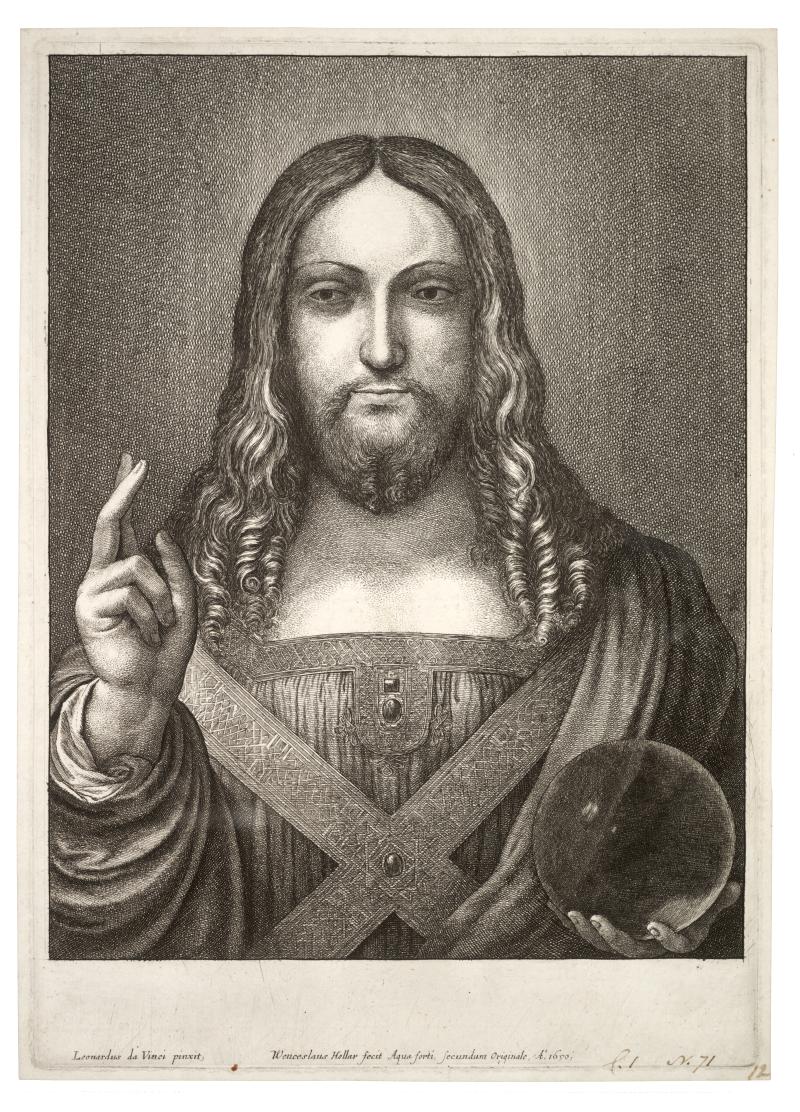

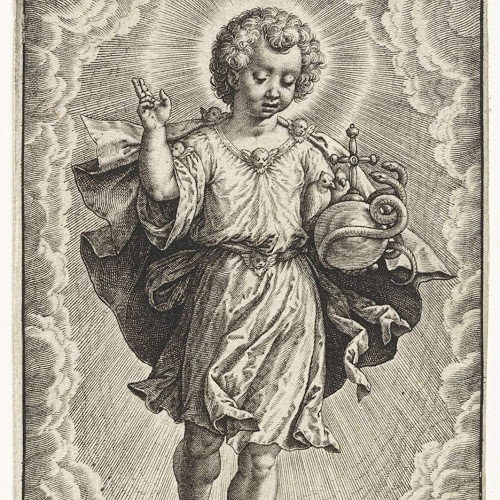
First Argument: On Baltic Oak
On 22 December 2019 I visited the exquisite exhibition around Bruegel’s The Adoration of the Magi in the Snow
at Winterthur (Sammlung Oskar Reinhart »Am Römerholz«). Knowing that the Salvator Mundi version of the Detroit
Institute of Arts is painted on Baltic oak (a fact only recently made known by Dianne Modestini, who also made known
the results of the dendrochronological examination) my attention was immediatedly drawn to the fact that Bruegel
(as Early Netherlandish painters, and as his Flemish contemporaries, and as Flemish painters after him)
had painted on Baltic oak. And I started to think about what all the informations gathered around this topic
by Bruegel scholarship (Baltic oak as being appreciated by painters, but also as being traded and especially as being
shipped from Eastern regions like today-Poland to harbors like Antwerp, where the actual panels had been made from raw planks)
might mean as for the Detroit painting, its eventual geographical localisation and its history. Until my visit at Winterthur
I had been unaware that in recent years ›Baltic oak scholarship‹ (as we may call it) has seen a kind of boom in the particularly
beautiful framework of Bruegel scholarship. And from knowing that a particular Salvator Mundi version is painted on Baltic oak,
there seems to result some kind of duty to think about how the results of Baltic oak scholarship could also be made
productive in the field of Salvator Mundi studies. The catalogue of the Winterthur exhibition includes a very informative essay
by Volker Dietzel (Zur Herstellung von Malgründen aus Eichenholz bei Gemälden von Pieter Bruegel dem Älteren),
inspiring a narrative that could be called ›the story of a Baltic oak‹ (since the wood of one particular tree
provided Bruegel with several panels). And inspired by this narrative we start to built our hypothesis, knowing also
of the results of the dendrochronological examination of the Detroit panel (which, as we said earlier, has proven
to be a desaster for countless connoisseurs who had placed the painting in the early 16th century): the Baltic oak
whose wood had been used for the Detroit Salvator Mundi version had been felled ›after 1569‹ which means that
it cannot be by Giampietrino or other Leonardesque painters who had died prior to that date.
Second Argument: Cherubim Associate with Flemish Salvator Mundi Iconography
The mere fact that the Detroit Salvator Mundi is painted on Baltic oak, despite the impression that Baltic oak
seems to ›cry‹ Antwerp, certainly is not enough to place the painting in Antwerp. Baltic oak, sought after also
for the making of barrels, might also have been shipped to English harbors at the time. But there is a second clue
that, we think, seems to link the painting with the city of Antwerp (with its over three hundred painters
that, according to a 1567 publication, were then working in the city (see Silver, Peasant Scenes, 2006, p. 17).
And this is a clue that is to be found in the painting: the four down-looking cherubim that are used as an ornament
on the stole.
Indicating or stressing a presence of the divine, cherubim might be seen as a didactic element added to a Salvator Mundi
painting in an atmosphere of Counter-Reformation, because they are additions to a Salvator Mundi type in which
they add to or replace a merely abstract ornament which would not have served the purpose of didactically
underscoring the presence of the divine. And as a matter of fact: where do we find Salvator Mundi iconography
to which cherubim have been added? We find it in Antwerp prints, and in the very same period in which also the
Detroit painting can be dated.
Certainly more research has to be done, but as for now the etcher Hieronymus Wierix has to named, as one,
or even as the one example of an artist associating cherubim with Salvator Mundi iconography. Several examples
can be found, with cherubim in the background or as parts of a cartouche, but also one particularly interesting example
of a young Christ with cherubim being part of his garment (picture: rijksmuseum.nl). And with this second clue, we think,
it is becoming more likely that the Detroit painting comes from the same, let’s call it an iconographic sphere or atmosphere,
and that it indeed could be an Antwerp painting, from the neighborhood, so to speak, of Hieronymus Wierix
and other artists.

Third Argument: Considering the Fact that Wenceslaus Hollar was in Antwerp in 1650
The question has been from the start in 1802: which painting was it, that the Bohemian etcher Wenceslaus Hollar
had seen, considered to be a painting by Leonardo and copied in 1650 (when Hollar was in Antwerp). The first answer
(in 1802, and by the antiquarian Hawkins) had been: the painting that, later, entered the Detroit collection, and
if this had been true, we would have to dismiss the Leonardo attribution by Hollar immediately, due to the results of the
dendrochronological testing.
But we are proposing a different hypothesis here anyway, the hypothesis that Hollar as well as the Master of the
Detroit Salvator Mundi saw a painting of Italian character that today is lost (and that, hence, the Hollar representation
and the Detroit Salvator Mundi are indirect relatives and not direct ones, as Hawkins had thought).
And here we have to say a word also on the Warsaw Salvator Mundi version, with, possibly, its satellite:
a rather unknown version in private hands, but formerly in Versailles. These seem to be paintings from roughly the same
period, and according to dendrochronological dating (as also made known by Dianne Modestini; see link above)
the Warsaw version is ›after ›around 1586‹‹. As the Detroit it is not, as had been often thought, a painting
from Leonardo’s workshop or circle (nor is probably its satellite). But we are facing the problem of having to place also
these Salvator Mundi versions geographically and into the general history of Salvator Mundi paintings. Are Warsaw
(with its Versailles satellite) versions made after a lost cartoon, or after the Detroit version (which we consider
to be a copy after a lost painting), or made directly or indirectly after this hypothetical lost painting?
Or even after another unknown lost one, directly or indirectly? These questions can only be raised at the moment
but not be answered.
We might interpret the fact that Hollar, in 1650, was in Antwerp as another clue to back the theory that in Antwerp,
at the time, a Salvator Mundi could be seen that also could have served as the model of the Detroit painting (and hence
the presence of Hollar in Antwerp could be seen as another – our third – clue to think that the Detroit Salvator Mund
is from Antwerp). And we are inclined to say that the fact that Hollar depicted an abstract ornament without cherubim
on the stole, that he might have preserved the ornament of the today-lost painting he saw and attributed to
Leonardo (not necessarily correctly), while the Master of the Detroit Salvator had reinterpreted the design in that,
among other things, he had added the cherubim.
The Warsaw Salvator, as we think, belongs into that very same group of Salvator Mundi representations, in that,
apart from its dating, the face of Christ is very similar as that by Hollar and that by the Master of the Detroit
painting, and it might be, as the Detroit Salvator Mundi, a ›witness‹ of the presence of a today-lost
painting in
the Netherlands or in France (since it is on French oak), but the main argument for our grouping of all these
representations of Christ as a Salvator Mundi together and to propose the hypothesis of a today-lost painting is
the connoisseurial argument that follows (pictures below: Detroit, Warsaw, Versailles, Hollar).
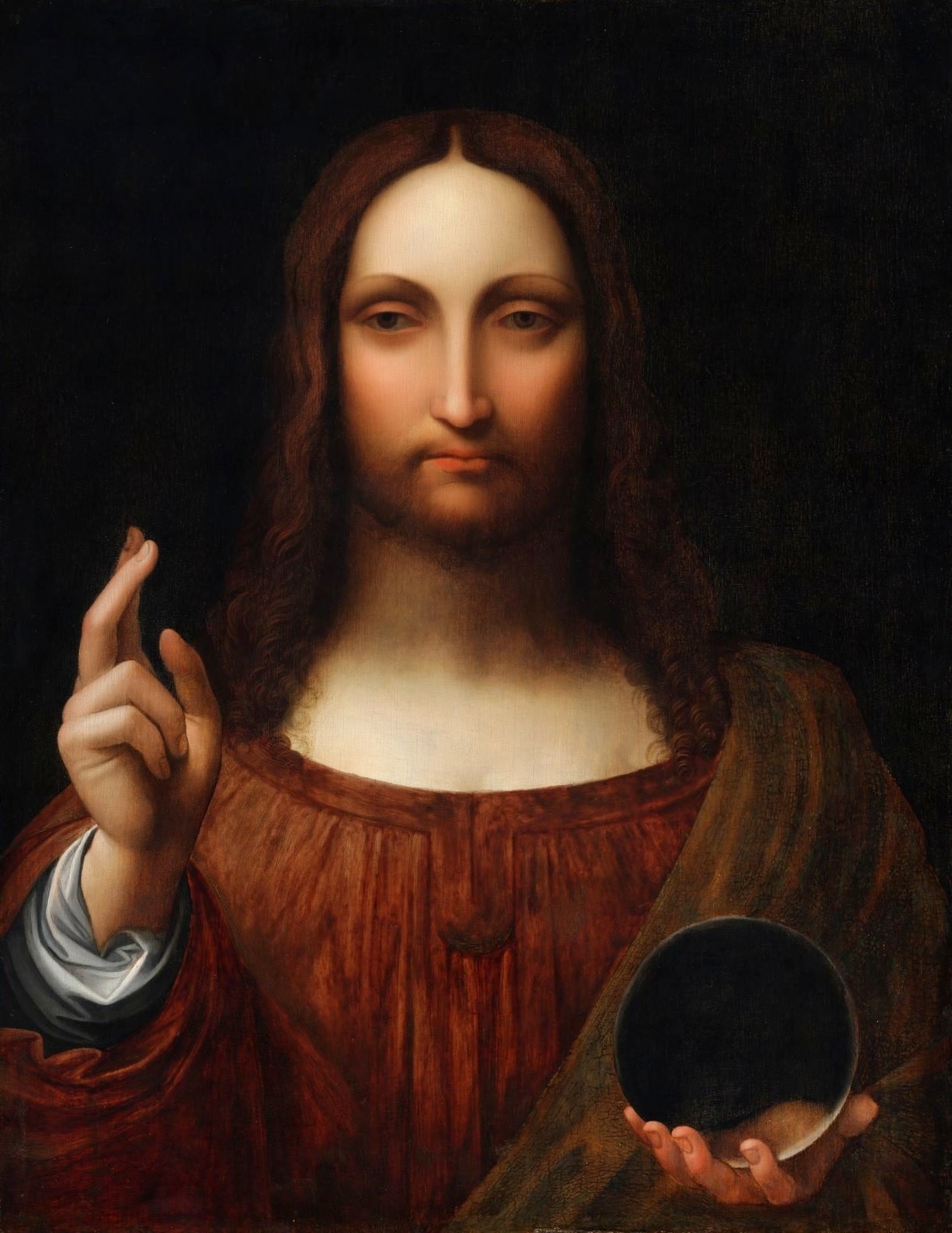


Fourth Argument: Likeness of Faces – Difference of Faces
When in 1646 Wenceslaus Hollar copied Leonardo’s drawing of five grotesque heads for Arundel (see below)
he masterfully retained the characterisation of all the figures depicted, while he did not stick literally to
copying every leaf in the wreath exactly. In other words: the theory that Hollar copied, in his 1650 etching, the
now notoriously famous Abu Dhabi Salvator Mundi, as its proponents have it, seems to be, at least to me, untenable.
Do we really have to assume that Hollar, in this case, changed virtually everything – not only the facial features,
the general physiognomy, the lighting, the ornaments, but also the level of optical naturalism as seen in the depiction of
the orb –, except that he maintained a literally marginal feature: the cropped margin at the right (see Dalivalle/Kemp/Simon,
Leonardo’s Salvator Mundi, 2019, p. 238), whose existence could be explained by an abundance of alternative theories?
If we compare the faces in Detroit, Warsaw and Versailles with Hollar on the one hand, and then Abu Dhabi with
Hollar on the other – it seems to me that the Abu Dhabi face of Christ has virtually nothing to do with Hollar;
while I have no problem to see common features in Detroit, Warsaw, Versailles and Hollar: especially an almost
stylisation of eyes, eye bow, nose, mouth and beard, that has some Oriental or also ›hieratic‹ connotations.
If we are comparing the nose only (especially its basis, the lower part), we see that Warsaw and Hollar are very,
very similar. And the question is: how to explain these similarities?
The hypothesis that I am proposing here (not a certainty, beware!) does explain these similarities by assuming
a common reference of Detroit and Hollar (and possibly also of Warsaw and Versailles): the today-lost painting
that was copied freely by an Antwerp master, and later by Hollar, also in Antwerp, who perceived it, not necessarily
correctly, as a Leonardo. This hypothesis also does imply, but I am making it explicit, that Hollar did not copy
the Abu Dhabi painting, nor did he reference it as a Leonardo.

Refutations of Anticipated Refutations:
I am conceding that one could argue that Detroit and Warsaw could be post/after Hollar, and that the similarities
between Detroit and Warsaw on the one hand and Hollar on the other therefore can be explained that it was the other
way round than most people would think: that painters copied the etching after 1650. But decades ago dendrochronologists
have come up with an average period of four to five years between felling date and actual use of a panel (one has
to think that raw planks have to dry for several years after the felling). It can be more, and we also have to think
that the period in question was war time, but we would have to assume that in the case of Detroit and Warsaw the period
would be much more than ten times the average, and this not only once but twice with two spectacular ›exceptions‹.
If you now would concede that there are similarities between Detroit, Warsaw and Hollar that are not in Abu Dhabi, and
that it is unlikely that Detroit and Warsaw are post-Hollar, it can only be explained by assuming that Hollar copied
one of them or another painting that was based on them – and this would also mean that the idea that Hollar copied
Abu Dhabi is falsified.
If you would argue that Hollar might have copied the Salvator Mundi from the Hamilton collection, a picture that
was, prior to 1650, shipped to Antwerp, this would also imply that the idea that Hollar copied Abu Dhabi is
falsified; as it would imply that Hamilton would be related to the Detroit group (directly or indirectly),
because of the similarities between Detroit and Hollar.
And if one would, using a last logical loophole, argue that the face of the Abu Dhabi Salvator Mundi has much suffered,
and that once it must have looked more like the Hollar etching, my reply would be: okay, I think this is purely
speculative, but then let us discuss the question of how much of it is really original. Also since Dianne Modestini
has already pointed to areas that she now thinks might not be original. And then let us also discuss what has been
said about Leonardo using his fingers to soften areas in the face, and finally let us discuss the contradictions
in the proponents’ narratives, among which we find some that tell us that virtually all of the face is original and
others that tell us, that only the best preserved parts around the face are original.
Consequences:
If my hypothesis proves to be tenable, it would mean that the Abu Dhabi Salvator Mundi would lose the ›backing‹ by
Hollar, who must have perceived another painting as being by Leonardo (again, not necessarily correctly).
Certainly one could still claim that the Abu Dhabi painting was by Leonardo, even if it would turn out that it was
never in any royal collection, but found by Father Hirst of Ratcliffe in a Venetian barbershop.
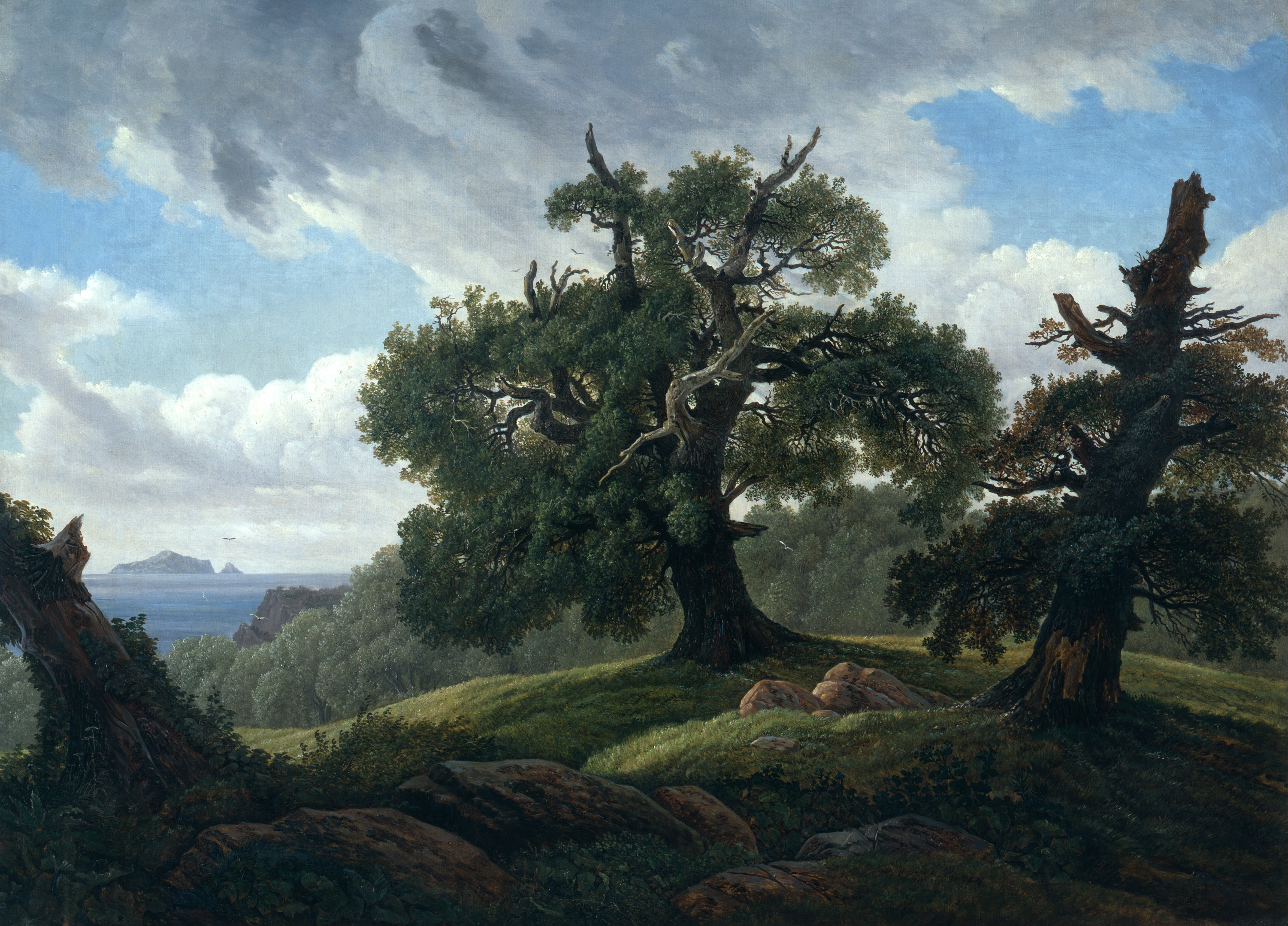
1566: Calvinistic iconoclasms; also iconoclasm at Antwerp.
1569: death of Pieter Bruegel the Elder; ›after 1569‹: the Baltic oak (or oaks) whose wood was being used to make the panels used for the Detroit Salvator Mundi version was felled (or were felled). (Painting above by Carl Gustav Carus: Memory of a Wooded Island in the Baltic Sea)
1585: Fall of Antwerp; ›around 1586‹: the French oak from which the panel of the Warsaw Salvator Mundi version was made was felled in the Seine river region. 
(Picture: goldennumber.net)
1650: Due to the above etching by Wenceslaus Hollar we face two everlasting questions: firstly, after which painting was it made? and: was the painting it was made after indeed, as the etching does say, a work by Leonardo da Vinci? This said, it might be, at least theoretically, that this etching was reproducing a picture not-made by Leonardo, and: that no actual prototype in terms of a finished painting by Leonardo did in fact exist (any more), even if the painting the etching was reproducing, indeed can be identified (see also below, sub 1915).
Two sheets with drapery studies from Windsor (pictures: lucyvivante.net) are to be considered as the other crucial reference works of any Salvator Mundi debate: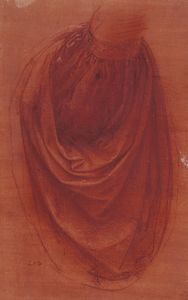

1651-1763: A Salvator Mundi of the Royal Collection which is ascribed to Leonardo da Vinci can be followed from the Royal collection to a 1763 sale (more details here).
Early 19th century: three Salvator Mundi versions in English collections, all of them linked with Leonardo, are known (and none of these are discussed by Heydenreich in 1964); moreoever: another version is in possession of the Earl of Yarborough (picture below: fondazionezeri.unibo.it; note here, as in chosen other versions, the also crucial Ω-shape (›omega shape‹; picture below: via.lib.harvard.edu) in the drapery, and compare with the one windsor sheet above on the right; present location of the picture is unknown).

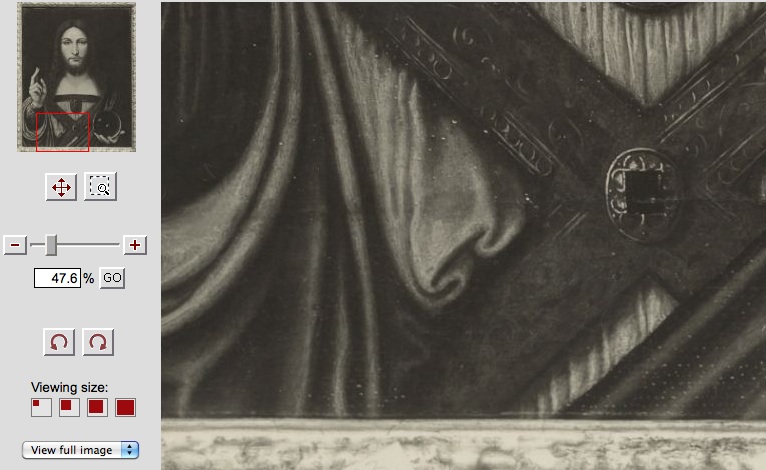
1869: John Ruskin, The Queen of the Air [with epoch-making praisal of Bernardino Luini].
1889: a Salvator Mundi (still ascribed to Giampietrino) is given to the Detroit Institute of Art (picture: dia.org):

1891: two Salvator Mundi versions, both from the collection of Giovanni Morelli and one of them depicting a young Christ, come to the Accademia Carrara of Bergamo (pictures: lombardiabeniculturali.it ; lacarrara.it):

1898: ›Masters of the Milanese and allied schools of Lombardy‹-exhibition at the Burlington Fine Arts Club (with catalogue)
1904: as a work by Quentin Matsys the later Zurich Salvator Mundi (see below) turns up at a sale at Cologne (Vente Bourgeois Frères at Heberle-Lempertz)
1907: Bernard Berenson, North Italian Painters of the Renaissance [with epoch-making dismissal of the Leonardeschi].
1915: Francesco Malaguzzi Valeri (La corte di Lodovico il Moro, vol. 2 (Bramante e Leonardo da Vinci), p. 558) points to a still all too little known 18th century source: Padre Vincenzo Monti, librarian of Santa Maria delle Grazie of Milan, speaks of a lunette painting done by Leonardo above a door in Santa Maria delle Grazie, a painting depicting the Saviour, and a painting which, according to this source, had been destroyed in 1603, due to an enlarging of this door. It may be that Salvator Mundi studies in general have neglected this source, blinded by the existence of the Hollar etching. Since it may also be that, if this lunette in fact did exist (and perhaps also a cartoon), all other derivatives might have been done by Leonardo pupils, which means that the whole Leonardesque Salvator Mundi family, including the model for the Hollar etching, might stem from this lost lunette. Italian scholars (P. C. Marani; C. Pedretti) have occasionally mentioned Monti’s testimony, his Catalogus, but Santa Maria delle Grazie has not especially been in focus of Salvator Mundi studies, all the more, of course, since the existence of minor works by Leonardo might have been outshadowed by the Last Supper.
(For an updated discussion of the above topic see now here.)
1929: Wilhelm Suida, Leonardo und sein Kreis (see also for the Italian subgroup of Salvator Mundi versions).
1964: ![]() Ludwig H. Heydenreich (picture: faz.de), Leonardo’s »Salvator Mundi« (Raccolta Vinciana, Fasc. XX; without mentioning, by the way, of the Monti testimony).
Ludwig H. Heydenreich (picture: faz.de), Leonardo’s »Salvator Mundi« (Raccolta Vinciana, Fasc. XX; without mentioning, by the way, of the Monti testimony).
recalls also a Warsaw version:

and also a Zurich version (then: Stark collection; present location unknown; picture: DS, after Raccolta Vinciana):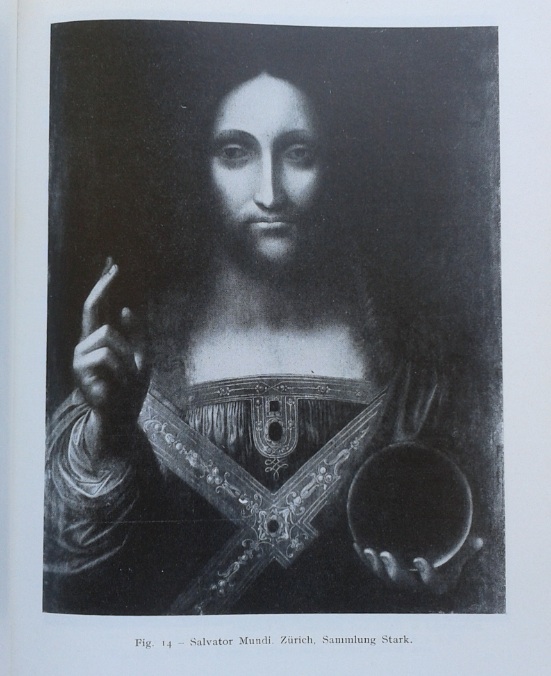

1982: Joanne Snow-Smith, The Salvator Mundi of Leonardo da Vinci. And we may speak of a end of 1970s and 1980s hypothesis that this is the painting the Hollar etching was made after (Salvator Mundi ex De Ganay; dismissed, by the way, by Berenson as the work of an inferior pupil of Leonardo; addition as of November 2017: Italian media have more than once assumed that Carlo Pedretti has been supporting the attribution of this version to Leonardo; Christie’s, in 2017, lays weight on the claim that Pedretti, as they believe, never asserted this; in 2011 Pedretti referred to the de Ganay picture as ›probably [by] Giampietrino‹ and dismissed the 21st century hypothesis (see further below), based on mere judgment by eye: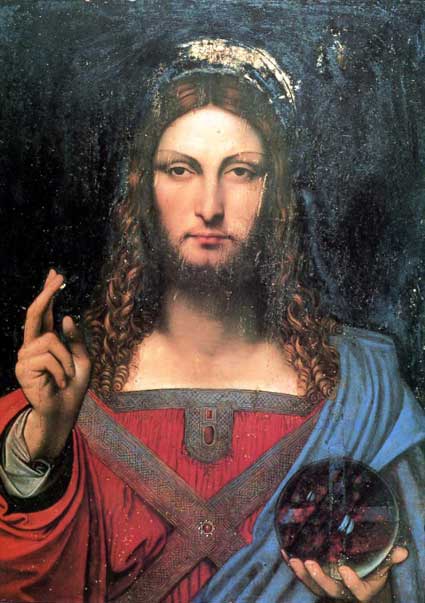

21st century: the Abu Dhabi Salvator Mundi is becoming notoriously famous.


And here again the version ex-Versailles that would, I believe, deserve somewhat more attention (picture: fondazionezeri.unibo.it)
(According to A. Vezzosi on canvas and in a private collection; angels added in 1843; in 1844 this work was donated to the Versailles Cathedral by archevêque Louis Blanquart de Bailleul)
2018: Baltic Oaks (exhibition of 16th and 17th century Dutch and Flemish pictures in the Latvian National Museum of Art at Riga; picture below: lnmm.lv).


See also:
Some Salvator Mundi Microstories
Some Salvator Mundi Afterthoughts
Some Salvator Mundi Variations
How To Tell Leonardo From Luini
MICROSTORY OF ART
ONLINE JOURNAL FOR ART, CONNOISSEURSHIP AND CULTURAL JOURNALISM
HOME
© DS